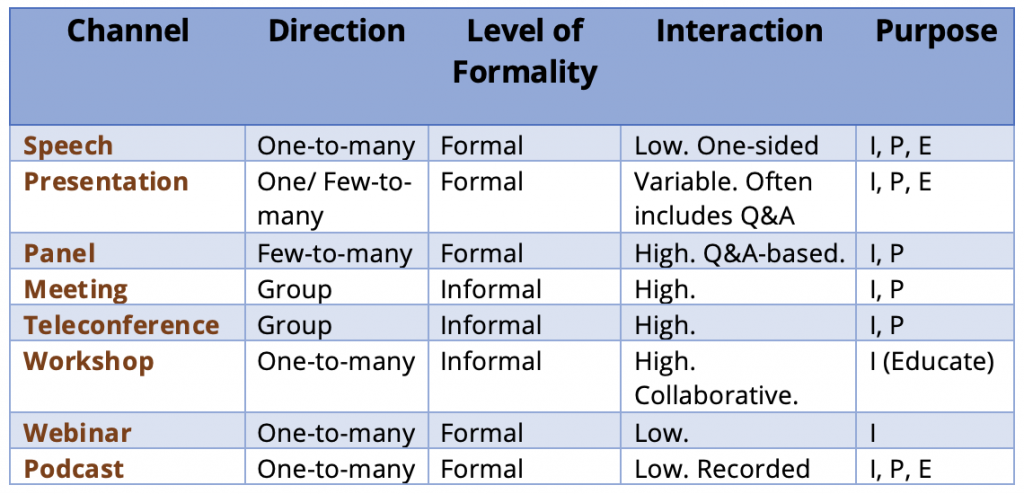18.2 Preparing a Presentation
Develop your message while keeping in mind the format, audience, style, and tone. First, you’ll need to think about the format of your presentation. This is a choice between presentation types. In your professional life, you’ll encounter the verbal communication channels in Table 18.1. The purpose column labels each channel with a purpose (I=Inform, P=Persuade, or E=Entertain) depending on that channel’s most likely purpose.
 Table 18.1 | Presentation Communication Channels
Table 18.1 | Presentation Communication Channels
There are some other considerations to make when you are selecting a format. For example, the number of speakers may influence the format you choose. Panels and Presentations may have more than one speaker. In Meetings and Teleconferences, multiple people will converse. In a Workshop setting, one person will usually lead the event, but there is often a high-level of collaboration between participants. The location of participants will also influence your decision. For example, if participants cannot all be in the same room, you might choose a teleconference or webinar. If asynchronous delivery is important, you might record a podcast. When choosing a technology-reliant channel, such as a teleconference or webinar, be sure to test your equipment and make sure each participant has access to any materials they need before you begin.
Once you have chosen a format, make sure your message is right for your audience. You’ll need to think about issues such as the following:
- What expectations will the audience have?
- What is the context of your communication?
- What does the audience already know about the topic?
- How is the audience likely to react to you and your message?
Next, you’ll consider the style of your presentation. Analyze your specific presentation styles. Perhaps you prefer to present formally, limiting your interaction with the audience, or perhaps you prefer a more conversational, informal style, where discussion is a key element. You may prefer to cover serious subjects, or perhaps you enjoy delivering humorous speeches. Style is all about your personality!
Finally, you’ll select a tone for your presentation. Your voice, body language, level of self-confidence, dress, and use of space all contribute to the mood that your message takes on. Consider how you want your audience to feel when they leave your presentation and approach it with that mood in mind.
Presentation Purpose
Your presentation will have a general and specific purpose. Your general purpose may be to inform, persuade, or entertain. It’s likely that any speech you develop will have a combination of these goals. Most presentations have a little bit of entertainment value, even if they are primarily attempting to inform or persuade. For example, the speaker might begin with a joke or dramatic opening, even though their speech is primarily informational. Your specific purpose addresses what you are going to inform, persuade, or entertain your audience with the main topic of your speech.
Incorporating Backchannels
Technology has given speakers new ways to engage with an audience in real-time, and these can be particularly useful when it isn’t practical for the audience to share their thoughts verbally—for example, when the audience is very large, or when they are not all in the same location. These secondary or additional means of interacting with your audience are called backchannels, and you might decide to incorporate one into your presentation, depending on your aims. They can be helpful for engaging more introverted members of the audience who may not be comfortable speaking out verbally in a large group. Using publicly accessible social networks, such as a Facebook Page or Twitter feed, can also help to spread your message to a wider audience, as audience members share posts related to your speech with their networks. Because of this, backchannels are often incorporated into conferences; they are helpful in marketing the conference and its speakers both during and after the event.

